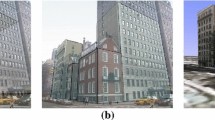Abstract
Within this paper, we present the implementation of a walkable virtual city model, created from aerial images of downtown Stuttgart. For this purpose, textured 3D meshes were automatically generated using commercial off-the-shelf multi-view stereo image matching software. This data provided the content for a VR framework based on the Unity game engine. Thus, an interactive data presentation using the HTC Vive virtual reality system was feasible. In addition to navigation, further user interactions such as simple tools for measurements inside the virtual model using handheld controller were implemented. According to our experience, this Stuttgart city walk is not only very attractive for presenting photogrammetric data to the general public at public relations activities, but could also be used as a low-cost and efficient 3D tool for interactive data editing in complex urban environments.
Zusammenfassung
Stuttgarter Stadtrundgang: Eine Untersuchung zur Visualisierung texturierter DOM-Netze zur Erzeugung einer virtuellen Realität. In diesem Artikel demonstrieren wir die Implementierung eines begehbaren, virtuellen Stadtmodells, erstellt aus Luftbildern des Stuttgarter Stadtzentrums. Zu diesem Zweck wurde automatisiert eine texturierte 3D Vermaschung mittels handelsüblicher Software für dichte Mehrbild-Stereozuordnung erzeugt. Diese Daten bildeten die Grundlage für ein Virtual-Reality-Framework basierend auf der Unity Spiel-Engine. Auf diese Art konnte eine interaktive Datenpräsentation unter Verwendung eines HTC Vive VR-Headsets verwirklicht werden. Zusätzlich zur Benutzernavigation können die dazugehörigen Fernsteuerungen auch für einfache Messungen innerhalb des virtuellen Modells verwendet werden. Der resultierende Stuttgarter Stadtrundgang ist unserer Erfahrung nach eine sehr eindrucksvolle Methode, der Allgemeinheit photogrammetrische Daten im Rahmen von Öffentlichkeitsarbeit näherzubringen. Potentiell bietet der Ansatz ein kostengünstiges und effizientes 3D Werkzeug zur interaktiven Messung in komplexen, urbanen Umgebungen.









Similar content being viewed by others
References
Deggim S, Kersten TP, Lindstaedt M, Hinrichsen N (2017) The return of the siegesburg—3d-reconstruction of a disappeared and forgotten monument. Int Arch Photogramm Remote Sens Spatial Inf Sci 42:209–215. https://doi.org/10.5194/isprs-archives-XLII-2-W3-209-2017
Käser DP, Parker E, Glazier A, Podwal M, Seegmiller M, Wang CP, Karlsson P, Ashkenazi N, Kim J, Le A, Bühlmann M, Moshier J (2017) The making of Google Earth VR. In: ACM SIGGRAPH 2017 Talks. ACM, New York, NY, USA, SIGGRAPH ’17, pp 63:1–63:2. https://doi.org/10.1145/3084363.3085094
Kersten TP, Tschirschwitz F, Deggim S, Lindstaedt M (2018) Virtual reality for cultural heritage monuments—from 3d data recording to immersive visualisation. In: Ioannides M, Fink E, Brumana R, Patias P, Doulamis A, Martins J, Wallace M (eds) Digital heritage. Progress in cultural heritage: documentation, preservation, and protection. Springer, Cham, pp 74–83
Kolbe TH, Gröger G, Plümer L (2005) Citygml: interoperable access to 3d city models. In: van Oosterom P, Zlatanova S, Fendel EM (eds) Geo-information for disaster management. Springer, Berlin, pp 883–899 10.1007/3-540-27468-5\_63
Rothermel M, Wenzel K, Fritsch D, Haala N (2012) Sure: Photogrammetric surface reconstruction from imagery. In: Proceedings LCD Workshop, Berlin, vol 8
Tschirschwitz F, Richerzhagen C, Przybilla HJ, Kersten TP (2019) Duisburg 1566: transferring a historic 3d city model from google earth into a virtual reality application. J Photogramm Remote Sens Geoinf Sci 87(1):47–56. https://doi.org/10.1007/s41064-019-00065-0
Tutzauer P, Becker S, Haala N (2017) Perceptual rules for building enhancements in 3d virtual worlds. i-com 16(3):205–213. https://doi.org/10.1515/icom-2017-0022
Zhang H, Manocha D, Hudson T, Hoff KE III (1997) Visibility culling using hierarchical occlusion maps. In: Proceedings of the 24th Annual conference on computer graphics and interactive techniques. ACM Press/Addison-Wesley Publishing Co., New York, NY, USA, SIGGRAPH ’97, pp 77–88. https://doi.org/10.1145/258734.258781
Acknowledgements
A considerable part of this work is based on the master thesis of Menghe Han. In addition, we would like to thank Lina Budde for her help during the implementations in Unity. In particular, we would like to thank the Surveying Office of the City of Stuttgart (Stadtmessungsamt Stuttgart) for providing the CityGML models as well as the aerial imagery.
Author information
Authors and Affiliations
Corresponding author
Rights and permissions
About this article
Cite this article
Schmohl, S., Tutzauer, P. & Haala, N. Stuttgart City Walk: A Case Study on Visualizing Textured DSM Meshes for the General Public Using Virtual Reality. PFG 88, 147–154 (2020). https://doi.org/10.1007/s41064-020-00106-z
Received:
Accepted:
Published:
Issue Date:
DOI: https://doi.org/10.1007/s41064-020-00106-z




